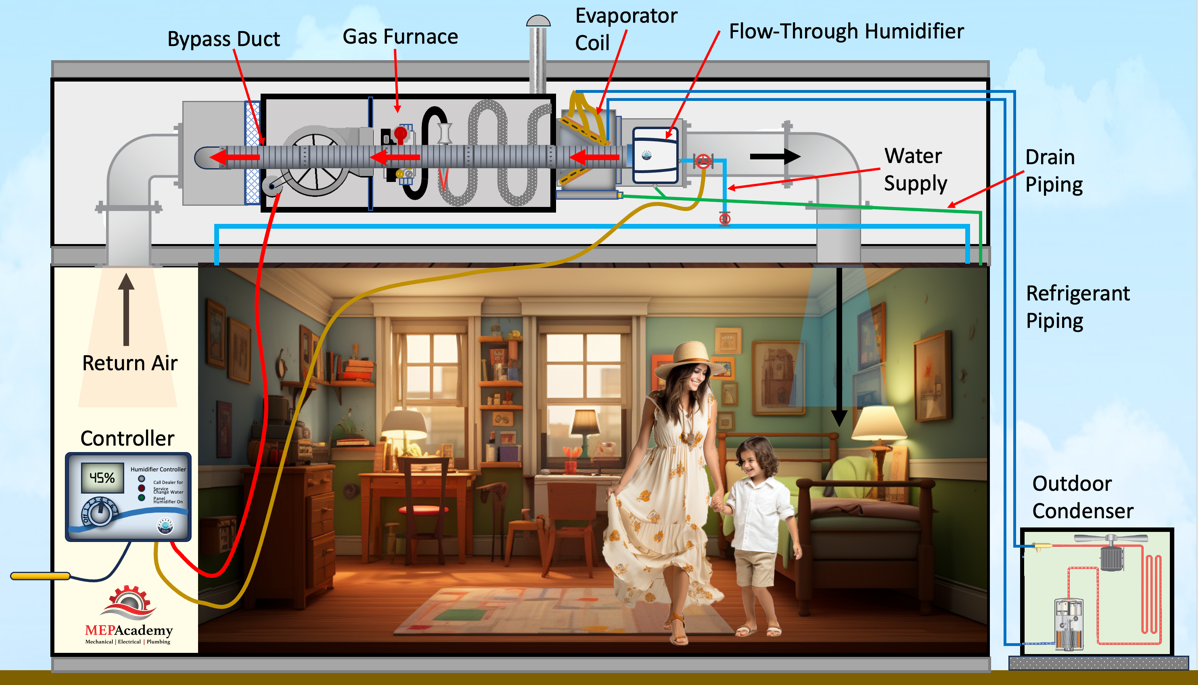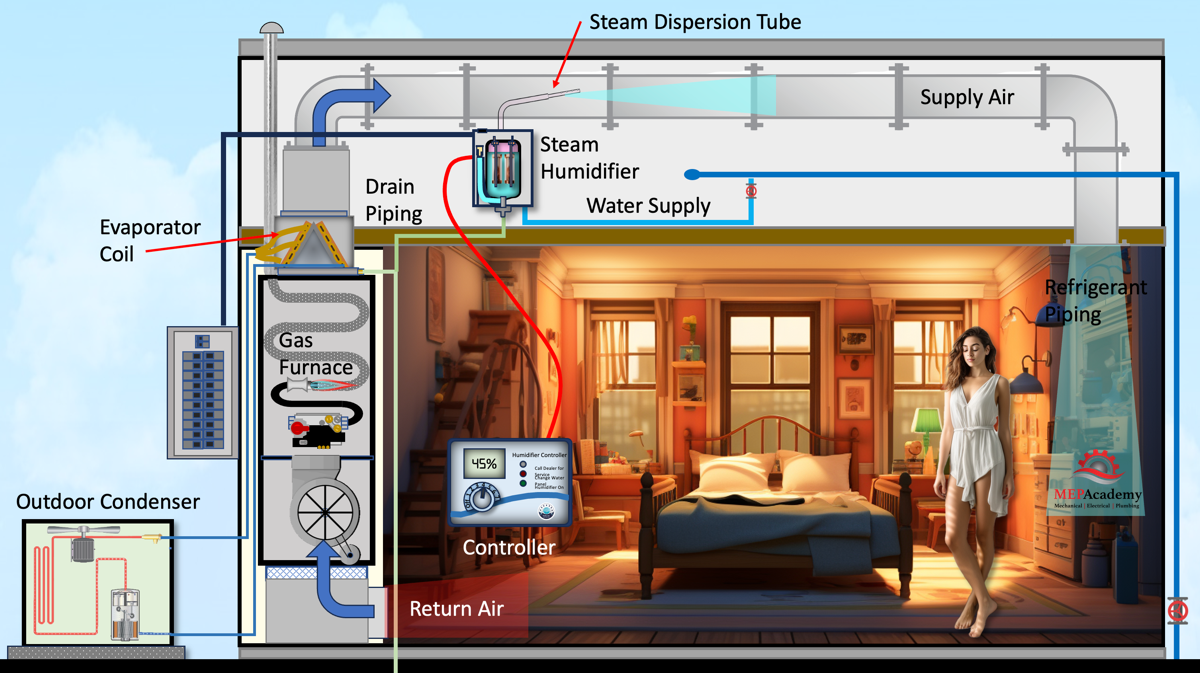- What is a Whole House Humidifier?
- Types of Whole House Humidifiers and how they work
- Benefits of Whole House Humidification
- Importance of Proper Humidity Levels in Homes
- The cost of a Whole House Humidifier
In this article, we’ll introduce you to whole house humidifiers, explain how they work, how much they cost, highlight their numerous benefits, and emphasize the importance of maintaining proper humidity levels in your home to reduce incidences of respiratory infections.
To watch the video of this presentation scroll to the bottom.
What is a Whole House Humidifier?
A whole house humidifier is designed to regulate and maintain the humidity levels in your entire home. Unlike portable humidifiers that only treat a single room, whole house humidifiers are integrated into your HVAC (Heating, Ventilation, and Air Conditioning) system. They work by adding moisture to the air circulated throughout your house, ensuring consistent and comfortable humidity levels in every room.
Types of Whole House Humidifier and how they work.
The three most common types are the Drum, Flow-through, and Steam-powered unit. Here’s is a brief explanation of how each of them work.

Drum (Bypass) Humidifier
A whole is cut into the supply air duct where the humidifier will be mounted. A drum humidifier consist of an absorbent pad that rotates on a drum. The drum rotates through a pan of water causing the pad to soak up water. A flexible bypass duct is installed from the return air side of the system into the humidifier. During summer when humidity isn’t required the bypass duct has a shutoff damper that prevents air from passing over the humidifier.
The home’s HVAC system fan forces dry air over the rotating drum. As the dry air passes over the moist pad rotating on the drum, the air picks up moisture through the process of evaporation. The moist humid air is then distributed throughout the home through the HVAC ductwork, increasing the indoor humidity levels.
Electrical power to a transformer provides low voltage operation of the humidistat and solenoid control valve. Some models come with a power cord that you plug into an outlet, saving you the extra step of wiring.
There are options for manual or automated control of the humidity level. With automatic control there may be an outside air sensor. Some humidistats have a simple dial that you turn to indicate whether you want more or less humidity. Mounting is often recommended to be on the return air duct or wall mounted.
These humidifiers require regular maintenance, including cleaning the drum and changing the water pad or foam, to prevent mold and bacterial growth and to ensure optimal performance.
Flow-Through Whole House Humidifier
A flow-through type whole house humidifier is also known as a bypass humidifier. Unlike the drum humidifier there is no rotating drum or reservoir of standing water. A flow-through humidifier operates by allowing water to flow continuously over a humidification medium, typically a water panel or evaporator pad.

Here’s how it works:
A flow-through humidifier is mounted on the supply air plenum after the coiling coil or furnace.
A small water tube will need to be tapped into a water pipe and then connected to the unit through a solenoid valve. A small drain line attached to the bottom of the humidifier allows for any condensate to be removed safely to a drain. If you have a cooling coil installed then there should already be a drain line that you can tap into.
Electrical power to a transformer provides low voltage operation of the humidistat and solenoid valve. Some models come with a power cord that you plug into an outlet, saving you the extra step of wiring.
When the home’s heating or cooling system is running, a portion of the dry air from the HVAC system is diverted through the flow-through humidifier. The diverted air passes over the water-saturated pad. As it does so, it picks up moisture through the process of evaporation.
The air, now with added moisture, is then distributed back into the home’s ventilation system and circulated throughout the entire house, effectively increasing the indoor humidity levels. The humidistat will control the operation of the humidifier, and is completely programable to the users liking.
There is also a fan powered flow through whole house humidifier version that works without a bypass duct, but will consume additional energy.
One of the advantages of flow-through humidifiers is that they use fresh water from the home’s supply, which can help reduce the risk of mold or bacterial growth associated with standing water. However, these systems do require regular maintenance, including replacing the water pad at regular intervals and cleaning the unit to ensure efficient operation and prevent potential issues with mold or mineral buildup.
Steam-Powered Whole House Humidifier
A steam-powered whole house humidifier is a type of whole house humidification system that uses electrically generated steam to increase the moisture content in the air throughout an entire home. This type of humidifier is known for its efficiency in quickly and effectively adding humidity to the indoor environment.

Here’s how it typically works:
The steam humidifier contains a heating element or electrode assembly immersed in a canister of water. When activated, the electrodes pass an electrical current between them causing the water to boil which produces the steam. A water supply line ensures that the humidifier has a constant supply of water. The generated steam is then introduced into the home’s HVAC ductwork through dispersion tubes extending into the supply air stream of the ductwork. As the steam mixes with the dry air from the HVAC system, it quickly condenses, releasing moisture into the air. This process raises the humidity levels in the home.
Steam humidifiers often come with built-in controls and sensors to monitor and adjust humidity levels automatically. This ensures that the indoor environment remains within the desired humidity range.
Steam-powered whole house humidifiers are known for their precision and ability to deliver humidity quickly, making them suitable for homes that require precise humidity control or those in extremely dry climates. They can be particularly effective for desert and arid climates and for larger homes where a significant amount of moisture is needed to achieve the desired humidity levels.
However, it’s important to note that steam humidifiers tend to consume more energy than other types of humidifiers and can be more expensive to purchase and install. Additionally, proper maintenance is essential to prevent issues like mineral buildup and to ensure long-term performance.
Benefits of Whole House Humidification
Whole house humidifiers offer a multitude of benefits that can enhance your overall well-being and home comfort:
Improved Health
Proper humidity levels help reduce the risk of respiratory issues, allergies, and skin dryness. They can also alleviate symptoms like dry throat, coughing, and congestion. See the importance of maintaining the proper relative humidity for health and for the mitigation of virus sustainability in our video on Commercial Humidifiers and How They Work.
Protects Your Home
Maintaining the right humidity levels is essential to safeguard your home’s structure and furnishings. Dry air can cause wood to crack, paint to peel, and electronic equipment to malfunction.
Enhanced Comfort
Balanced humidity levels make your living environment more comfortable year-round. You’ll feel warmer in the winter and cooler in the summer, reducing the need for excessive heating or cooling.
Energy Efficiency
Proper humidity levels allow you to feel comfortable at slightly lower temperatures during the colder months, which can lead to energy savings and reduced utility bills.
Importance of Proper Humidity Levels in Homes
Maintaining the right indoor humidity levels is crucial for several reasons:
Health and Comfort
Inadequate humidity can lead to discomfort and health issues. Dry air can cause dry skin, irritated eyes, and worsen respiratory conditions like asthma.
Preservation of Your Home
Protect your home’s structure and contents. Proper humidity prevents wooden furniture, flooring, and musical instruments from drying out and becoming damaged.
Energy Efficiency
Balancing humidity levels can help you maintain comfort without overworking your heating or cooling systems, saving energy and money.
Seasonal Adjustments
Humidity requirements change with the seasons. Whole house humidifiers allow for easy adjustments to ensure comfort throughout the year.
The Cost of Whole House Humidifiers
The cost of a whole house humidification systems depends on the make and style of humidifier chosen. According to Angi, in 2023 the average whole house humidifier cost ranges from $397 to $753, with an average of $575. The high end could reach $1,200. The cost ranges between the different type of humidifiers.
Checkout the Current Cost of Humidifiers
The actual equipment cost varies, with the Drum humidifier ranging from $150 to $250. Flow through humidifiers ranging from $175 to $450, and steam humidifiers costing between $300 and $1,100.
Some of the humidifiers come with an installation kit, that contains a transformer, outdoor temperature sensor, water valve, hose clamps, thermostat wire, drain and water supply tubing.
| Budget Amount | Humidifier Type |
| <$250 | Drum |
| $175 to $450 | Flow-through |
| $400 to $1,000 | Steam-powered |
| $1,000 + | High-end steam |
Again, according to angi, it can take up to 5 hours to install a whole house humidifier, which could cost you $400.
For homes that have more than one air conditioner, each would require their own humidifier.
Humidifier Coverage Area
The age of the home could also affect the size of the humidifier required. Older homes that are poorly sealed would require a larger humidifier to make up for losses through the loose construction. For example, the AprilAire Model 700 will cover an area of up to 5,300 Ft2 for a home with tight construction, while that same humidifier is only good for up to 2,700 ft2 for average construction and up to 1,800 ft2 for loose construction.
In conclusion, whole house humidifiers offer a comprehensive solution to combat dry indoor air, providing numerous health benefits and preserving the integrity of your home. Proper humidity levels are key to creating a comfortable and healthy living environment for you and your family. Proper maintenance is required to keep them running properly and safely.
Frequently Asked Questions (FAQ)
Q. Can a Bypass Flow Through Humidifier be installed on the Return Duct?
A. Yes, some manufacturers allow for installation on the return side of the system. The preferred location is on the supply duct, but if space doesn’t allow, the return duct is often acceptable.
Q. Is it healthy to run the Humidifier every night?
A. Yes, maintaining your humidity level between 40 and 60% relative humidity has shown to improve your health and reduce incidences of respiratory infection.






